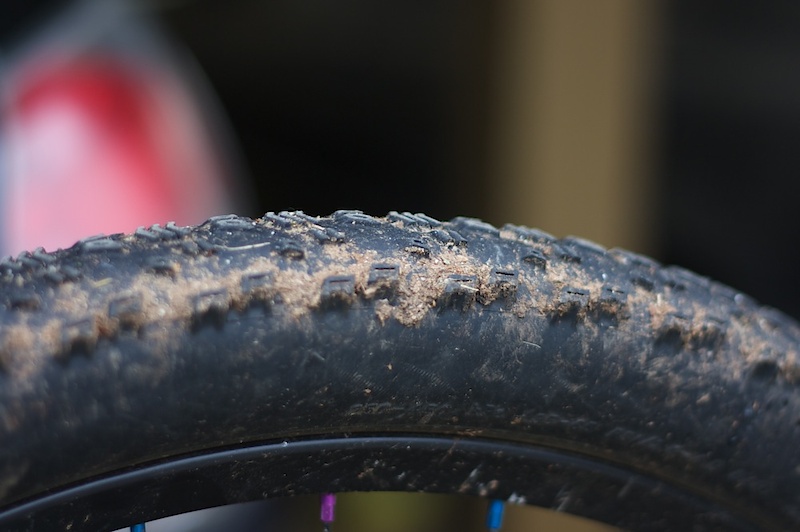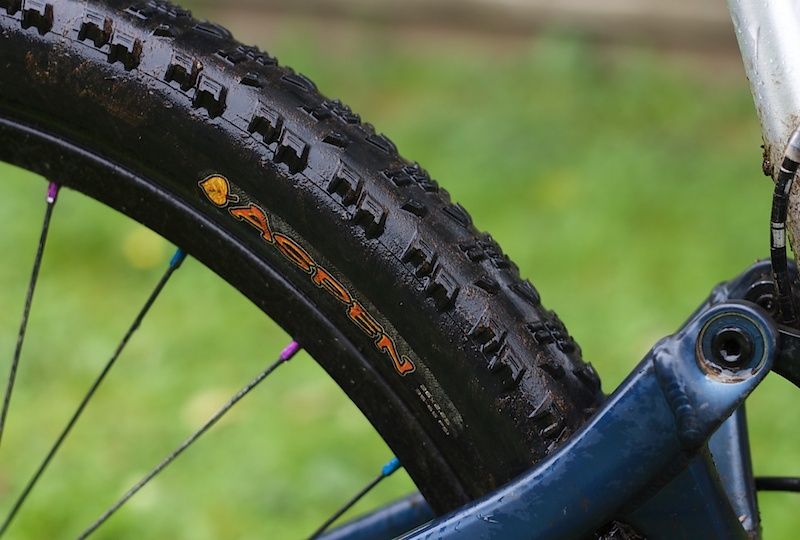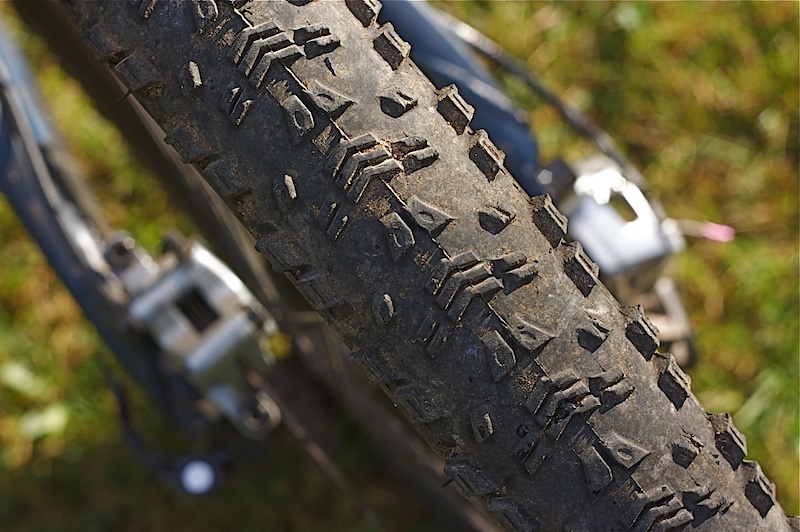Maxxis Aspen tire review
I enjoy riding fast, rolling singletrack but have no problem dialing up the tech on the steep and rooty stuff that is really common in this area. To that end, I'm always on the lookout for a fast-rolling tire that can hold its line through varying terrain. The Maxxis Aspen falls into this category and I've been running the tire for the past few months to see if it can live on the edge as a summer and fall tire.
Read on,
Technical info:
There are eight versions of the Maxxis Aspen, and each has its own width (2.1", 2.25"), TPI (60, 120), bead (folding, wire), and size (26", 29"). All variants incorporate a mixed 62/60 durometer rubber compound, with a higher duro center ridge being complemented by softer corner knobs. The 2.25" Aspen used for this test employed a folding bead with a durable 60 TPI casing and it weighed in at 710 grams, which is about 25% higher than what is claimed (570g) on the Maxxis website.
Editor's note - Our Aspen tires were from the first production run (710grams) and have since dropped to 570g thanks to changes made by the tire's engineers. This has resulted in an even lighter and faster rolling tire.
The Aspen can serve as both a front and rear tire, but it was used only as a rear tire for this review. It was paired with a 2.5" Maxxis Minion DHF EXO for the duration of the test.
On the bike:
After throwing a tube into the tire, inflating it to 32psi on my Stan's Olympic rim, and installing the wheel on the test bike, the first thing I noticed about the Aspen was that it is honking big for a 2.25" tire, so keep that in mind if tire clearance is a known issue for your frame. On the trail, the tire's high volume benefits the rider by smoothing out trail chatter and reducing the likelihood of a buzz-killing pinch flat, while the rounded tire profile makes for predictable, stable cornering, as there isn't a whole lot of unpredictability or slippage as you transition from the center to the relatively aggressive, if rather small, side lugs.
![photo]()
With its chevron-shaped center tread, the Aspen excels while riding on hardpack, hooking up without fail and rolling extremely fast despite its rather portly weight. The tire breaks free occasionally while climbing in loose and dry summer conditions, but inevitably regains its footing on the next pedal stroke and has much more bite in these conditions than a tire like Maxxis' own CrossMark. In the wet, the minimalist tread sheds mud, dirt, and leaves exceptionally well, leaving the tire to do its work and the rider to concentrate on the task at hand instead of worrying about a tire that is packed up with dirt.
The Aspen performs similarly on downhill sections of trail, blazing down hardpack trails, while remaining skittish on loose washboard and over wet roots and rocks. Outside of its comfort zone, the tire doesn't offer the best braking performance I've experienced in a cross country tire, as the Aspen is prone to skipping around on rough and loose descents, but it's still decent enough when compared with other cross country tires. In these cases, one of the many tires with beefier treads in the 2.35" range would be more suitable.
The tire was run for about four months of trail riding and there were no catastrophic failures during that time. Pinch flats were never an issue and I experienced no sidewall tears or cuts while riding plenty of the rocky trails that litter British Columbia's southwest region. I had no problems airing it up with sealant and Stan's rim tape either, and the tubeless setup offered great compliance and rolling speed.
As for durability, the softer durometer side lugs and the transitional blocks are starting to show signs of breaking down, but in my opinion, the tire's excellent performance trumps any premature wear that you might experience. Whether or not you can live with that wear life depends on what you expect out of your tires (ie. durabilty vs. cost. vs. performance).
Sizing up the Maxxis Aspen
The Maxxis Aspen is marketed as a cross country tire, but it performs well enough in most conditions that it deserves consideration from trail riders looking for a fast, three-season tire. You will appreciate the Aspen if lots of pedaling is part of your repertoire and your trails are flowing ribbons of dirt during the spring, summer, and fall. Its high volume casing smooths out trail chatter and its fast-rolling tendencies are coupled with excellent hardpack traction while climbing and during most descents.
The Aspen is least impressive on loose-over-hard terrain where the tread's shallow center doesn't provide the same amount of bite as a beefier tire. Similarly, it's not great in the wet and mud (ie. some fall and most winter weather) although it isn't so terrible that it should be disqualified from occasional rides in these conditions. Wear life isn't fantastic, with the test tire starting to show side-lug wear after about four months of riding.
Overall, I was impressed by the Aspen and, based on my experience with the tire over the past couple months, wouldn't hesitate to recommend it for a rider who likes to put in mileage, but still appreciates the benefits of the tire's surprising traction in most conditions. The Aspen is not a freeride tire and it doesn't excel in many "Shore-type" situations, but it is more than capable as a trail tire that can be used until the trails get really wet and / or muddy.
MSRP: $50 (USD)
Manufacturer's website: www.maxxis.com
Read on,
Technical info:
There are eight versions of the Maxxis Aspen, and each has its own width (2.1", 2.25"), TPI (60, 120), bead (folding, wire), and size (26", 29"). All variants incorporate a mixed 62/60 durometer rubber compound, with a higher duro center ridge being complemented by softer corner knobs. The 2.25" Aspen used for this test employed a folding bead with a durable 60 TPI casing and it weighed in at 710 grams, which is about 25% higher than what is claimed (570g) on the Maxxis website.
Editor's note - Our Aspen tires were from the first production run (710grams) and have since dropped to 570g thanks to changes made by the tire's engineers. This has resulted in an even lighter and faster rolling tire.
The Aspen can serve as both a front and rear tire, but it was used only as a rear tire for this review. It was paired with a 2.5" Maxxis Minion DHF EXO for the duration of the test.
On the bike:
After throwing a tube into the tire, inflating it to 32psi on my Stan's Olympic rim, and installing the wheel on the test bike, the first thing I noticed about the Aspen was that it is honking big for a 2.25" tire, so keep that in mind if tire clearance is a known issue for your frame. On the trail, the tire's high volume benefits the rider by smoothing out trail chatter and reducing the likelihood of a buzz-killing pinch flat, while the rounded tire profile makes for predictable, stable cornering, as there isn't a whole lot of unpredictability or slippage as you transition from the center to the relatively aggressive, if rather small, side lugs.

Maxxis Aspen with four months' wear. Note the shallow tread depth and widely spaced lugs that help the tire roll great on hardpack. The tread pattern also contributes to mediocre performance in the wet, but the Aspen isn't meant to be an all-season, all-rounder.
With its chevron-shaped center tread, the Aspen excels while riding on hardpack, hooking up without fail and rolling extremely fast despite its rather portly weight. The tire breaks free occasionally while climbing in loose and dry summer conditions, but inevitably regains its footing on the next pedal stroke and has much more bite in these conditions than a tire like Maxxis' own CrossMark. In the wet, the minimalist tread sheds mud, dirt, and leaves exceptionally well, leaving the tire to do its work and the rider to concentrate on the task at hand instead of worrying about a tire that is packed up with dirt.
The Aspen performs similarly on downhill sections of trail, blazing down hardpack trails, while remaining skittish on loose washboard and over wet roots and rocks. Outside of its comfort zone, the tire doesn't offer the best braking performance I've experienced in a cross country tire, as the Aspen is prone to skipping around on rough and loose descents, but it's still decent enough when compared with other cross country tires. In these cases, one of the many tires with beefier treads in the 2.35" range would be more suitable.
The tire was run for about four months of trail riding and there were no catastrophic failures during that time. Pinch flats were never an issue and I experienced no sidewall tears or cuts while riding plenty of the rocky trails that litter British Columbia's southwest region. I had no problems airing it up with sealant and Stan's rim tape either, and the tubeless setup offered great compliance and rolling speed.
As for durability, the softer durometer side lugs and the transitional blocks are starting to show signs of breaking down, but in my opinion, the tire's excellent performance trumps any premature wear that you might experience. Whether or not you can live with that wear life depends on what you expect out of your tires (ie. durabilty vs. cost. vs. performance).
Sizing up the Maxxis Aspen
The Maxxis Aspen is marketed as a cross country tire, but it performs well enough in most conditions that it deserves consideration from trail riders looking for a fast, three-season tire. You will appreciate the Aspen if lots of pedaling is part of your repertoire and your trails are flowing ribbons of dirt during the spring, summer, and fall. Its high volume casing smooths out trail chatter and its fast-rolling tendencies are coupled with excellent hardpack traction while climbing and during most descents.
The Aspen is least impressive on loose-over-hard terrain where the tread's shallow center doesn't provide the same amount of bite as a beefier tire. Similarly, it's not great in the wet and mud (ie. some fall and most winter weather) although it isn't so terrible that it should be disqualified from occasional rides in these conditions. Wear life isn't fantastic, with the test tire starting to show side-lug wear after about four months of riding.
Overall, I was impressed by the Aspen and, based on my experience with the tire over the past couple months, wouldn't hesitate to recommend it for a rider who likes to put in mileage, but still appreciates the benefits of the tire's surprising traction in most conditions. The Aspen is not a freeride tire and it doesn't excel in many "Shore-type" situations, but it is more than capable as a trail tire that can be used until the trails get really wet and / or muddy.
MSRP: $50 (USD)
Manufacturer's website: www.maxxis.com
Author Info:
Must Read This Week
Sign Up for the Pinkbike Newsletter - All the Biggest, Most Interesting Stories in your Inbox
PB Newsletter Signup



However, if I had to choose between an Aspen and a Crossmark I would probably reach for the Crossmark as it seems to last quite a bit longer.
Think of it more like a pinner version of the Ardent where you have to lean the bike quite a ways to get the side knobs to hook up.
We shall see.